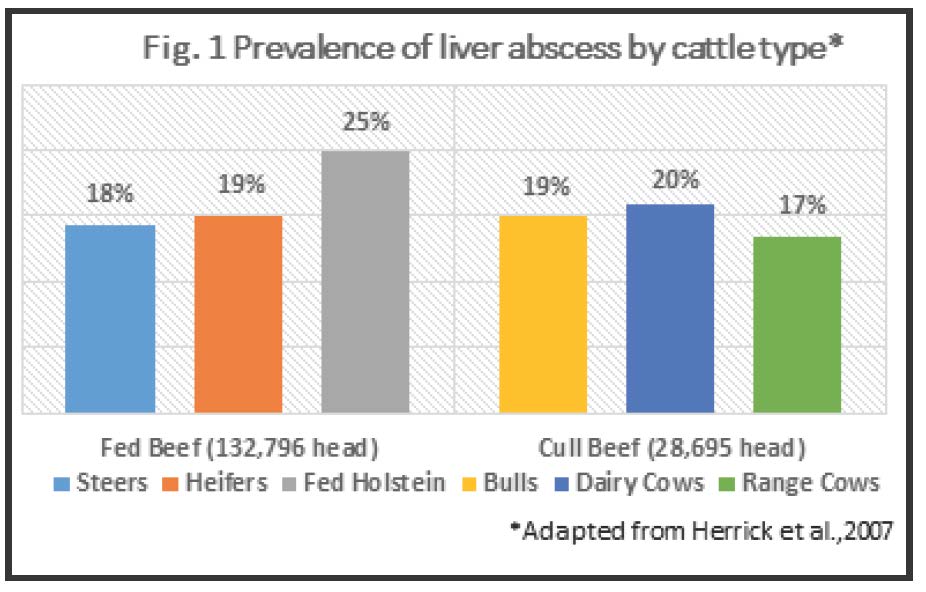
By Dr. Aimee Hafla, Ph.D., PAS
Abscesses occurring on the livers of cattle are the primary cause of liver condemnation at the packing plant and result in an estimated loss of up to $64 million annually for the beef industry in the United States (Herrick et al., 2017). A recent liver audit of 11 processing facilities found that fed Holsteins had the greatest incidence rate of liver abscesses at 25%, followed by cull dairy cows at 19%, with fed beef steers having an 18% incidence rate (Figure 1; Herrick et al., 2017). Cattle producers need to understand that this isn’t just a problem for the packers, but that liver abscesses negatively impact cattle performance in the feed yard. The presence of severe liver abscesses significantly reduces ADG, feed intake, and hot carcass weight. Based on an average reduction in carcass weight of 22 lbs. (Reinhardt and Hubbert, 2015) and a current beef carcass price of $2.35/lb (USDA, AMS 2017), a steer with severe liver abscesses would be worth $51.70 less than that of his counterpart, with a normal, healthy liver. If you consider lost carcass value and reductions in live animal performance, the total economic impact is even greater.
Causes
Rumenitis (damage to the ruminal wall) caused by acute and chronic acidosis, or by physical insult (hair, foreign objects, etc.), create a pathway for pathogenic bacteria to escape and pass to the liver, where abscesses form. The primary bacteria associated with liver abscesses is Fusobacterium necrophorum, which is an organism commonly found on the wall of the rumen.
Control and prevention
Forage level and processing: Forage level plays an important role in the development of acute and chronic acidosis, and subsequently rumenitis, and therefore influences the prevalence of liver abscesses. It is recommended that forage be included at a minimum of 8% of the diet and effective NDF (NDF solely from forage sources) fall between 7 and 10% of diet dry matter. The NDF from corn co-products does not provide the same benefit to the rumen as effective NDF, which is why it is imperative to evaluate effective NDF when formulating high energy finishing rations. It is important to recognize that the minimum inclusion rate of 8% forage is adequate only if the forage is sufficiently coarse enough to provide rumen stimulation and buffering. A minimum chop length of 2 inches is recommended for forages in high energy finishing rations.
Feedbunk management: Consistent levels of feed intake are imperative for decreasing the risk of acidosis and subsequently the occurrence of liver abscesses. A bunk scoring system should be used to make feed delivery decisions each day. It is recommended that feed offered never be increased or decreased by more than 5% of the previous days feeding. Managing dietary changes are an important part of bunk management. While F. necrophorum is naturally found in the rumen, populations of this bacteria can increase 10-fold when cattle are transitioned from a high-forage ration to a high concentrate ration (Tan et al., 1994). A survey of consulting feedyard nutritionists indicated that an average of 4 step-up rations is used to adapt cattle to their final finishing ration in large commercial yards (Samuelson et al., 2016). Feed mixing and presentation are central to ensuring that cattle consume the correct proportions of nutrients in each bite. Be sure scales and mixers are functioning properly. Evaluate the efficacy of equipment and mixing protocol with nutrient analysis of the finished ration from several locations within the bunk. Finally, feed that is too wet may spoil in the bunk, in contrast, feed that is too dry will allow for sorting. Sorting and refusal of forage will subject cattle consuming a high energy ration to acidosis and rumen upset.
Feed additives and vaccines: Tylosin is the most commonly used antimicrobial intervention for liver abscesses in feedlot cattle. Tylosin administered daily at 60 to 90 mg/head has been shown to reduce the prevalence of liver abscesses by up to 70% (Nagaraja and Chengappa, 1998). While tylosin is effective, liver abscesses may still occur and there is significant public concern about the daily use of antibiotics in livestock. Tylosin, and the other antibiotics approved for the prevention of liver abscesses, currently require veterinary oversight and cannot be obtained without a valid Veterinary Feed Directive (VFD).
Essential oils, such as limonene and thymol, have demonstrated some ability to inhibit the growth of F. necrophorum (Elwakeel et al., 2013), however, dosage and potential impacts on other biological processes require further research. Feedlot cattle consuming yeast fermentation products may have a slightly lower prevalence of liver abscesses (23.5 vs. 19.2%; Wagner et al., 2016). Yeast and yeast fermentation products may help stabilize the rumen, alter fermentation parameters, and modulate feed intake, however, more research is needed to determine the effectiveness of these products to reduce the occurrence of liver abscesses.
The first step in preventing and controlling the occurrence of liver abscesses in feedlot cattle is prudent nutritional management. The Agri-King beef feeding program carefully monitors forage level and level of effective NDF in high energy rations to ensure you get the greatest performance while maintaining the health of your cattle. If you have questions about improving your bunk management or performing a TMR mix audit, ask your trusted Agri-King nutrition consultant for guidance. AK
*Literature Cited – Available on Request
